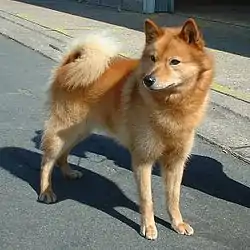Laika (dog breed)
Laika (Russian: Ла́йка, IPA: [ˈlajkə]) is a type of hunting dog of Northern Russia and Russian Siberia, and is a generic name for several breeds. Laika is also the given name for the mongrel who was the first dog in space.
| Laika | |
|---|---|
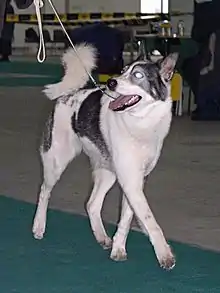 East Siberian Laika | |
| Origin | Russia |
| Dog (domestic dog) | |
_Dogs_driving_lynx.jpg.webp)
International terminology
Internationally recognized hunting laikas
Fédération Cynologique Internationale uses the word Laika in the names of three standard breeds: Russian European Laika (FCI standard No. 304), West Siberian Laika (FCI 306), and East Siberian Laika (FCI 305), which had been bred from the aboriginal dogs of northern Russia and Siberia.
Sled laikas
The Yakutian Laika is a multi-purpose laika breed from the Sakha Republic, used both in bird and seal hunting, reindeer herding, and sled pulling. However, nowadays it is solely a sled dog.[1] So far it has been officially recognized in Russia, Estonia, Belarus, Ukraine, Czech Republic, Nordic Countries, and Brazil. In the US, it has been accepted to the Foundation Stock Service by the American Kennel Club.
The Northeastern Hauling Laika is a sled dog from East Siberia. It is not known as a "laika" breed in its original country of Russia, but rather as the "Northeastern Sled Dog" (severo-vostochnaya yezdovaya sobaka), so in its case the term "laika" is simply international or Western use. It is typically 58 to 69 cms at height, weighing 34 to 50 kg, and its coat can occur in any colour.[2]It is currently unrecognized, even in Russia.

 Northeastern Hauling Laika
Northeastern Hauling Laika
Herding laikas
The Nenets Herding Laika, also known as the Reindeer Herding Laika or Olenegonka[3] is the ancestor of the Samoyed - bred by Nenets people. It is used as a reindeer herding dog in northeastern Europe and West Siberia.[4] Unlike the Samoyed, it has different colour variations, such as white, red, brown, sable, grey, black and piebald.[4][3] It is officially recognized in Russia and Estonia.
Rare hunting laikas
The Karelo-Finnish Laika, not listed in the FCI nomenclature, was a small Russian hunting dog, with the first standard published in Leningrad in 1936 by the Russian Kennel Federation. It was a close relative of the Finnish Spitz, as both breeds were bred from similar native dog populations.[5] In 2006, the Russian Kennel Federation and the Finnish Kennel Club decided to merge the Karelo-Finnish Laika and the Finnish Spitz together as only one breed (the Finnish Spitz). This helped to improve the gene pool of both the Russian and Finnish populations.[6]
- In addition, the Russians have described a separate breed called the Karelian Laika (Карельская лайка), descending from the Old Karelian "Zverovoy" Laika.
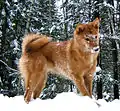
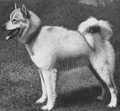 Karelian Laika
Karelian Laika
Other hunting Laika breeds or local variations that have been mentioned in international bibliographies include:
- Amur Laika: a hunting dog from Amur Oblast[7]
- Bashkir Laika: a hunting dog from Bashkortostan, developed by the Bashkirs[8]
- Cheremiss Laika: a hunting dog from the Mari El Republic, developed by the Mari people[9]
- Chootch Laika: a hunting dog from Siberia[9]
- Finno Laika: a hunting dog from the European part of Russia[10]
- Irkutsk Laika: a hunting dog from Irkutsk Oblast[7]
- Korel Laika: a hunting dog from the European part of Russia, probably named after Korelskoye[11]
- Lapland Laika: a hunting dog from the European part of Russia, especially "Russian Lapponia" (Murmansk Oblast)[11]
- Tofolar Laika: a hunting dog from Irkutsk Oblast, developed by the Tofalars[7]
- Tunguse Laika (also known as Evenki Laika[7]): a hunting dog from the Tungus Republic, developed by the Evenks[12]
- Vogool Laika: a hunting dog from Khanty-Mansi Autonomous Okrug, developed by the Mansi people[12]
- Zorian Laika: a hunting dog from the European part of Russia[12]
Use of the word in Russia
The Russian word laika (Russian: лайка) is a noun derived from the verb layat'' (Russian: лаять, to bark), and literally means barker. As the name of a dog variety, it is used in Russian cynological literature (not only in Russian, but sometimes in English as well) to refer to all varieties of hunting dogs traditionally kept by the peoples of the northern Russia and adjacent areas. This includes not only the three or four breeds known as Laikas in English, but also other standard breeds that the FCI classifies together with them as "Nordic Hunting Dogs" (Group 5, Section 2 of the FCI classification).[13]
Thus, the Norwegian Elkhound is known in Russian literature as Norwegian Elk Laika (норвежская лосиная лайка), and the Finnish Spitz as Finnish Bird Laika (финская птичья лайка).
In Russia the word laika is sometimes used less strictly, to refer not only to hunting dogs but also to the related sled dog breeds of the tundra belt, which the FCI classifies as "Nordic Sled Dogs". The Samoyed may be occasionally referred to as the Samoyed Laika (Самоедская лайка)[14] - however, this name also refers to the nationally recognized (in the Russian Kennel Federation) Nenets Herding Laika.
Similar breeds
As the spitz is a very ancient dog type, many smaller types of spitz resemble each other. Small to medium-sized breeds similar in appearance from various places in the world include the Wolfsspitz (or Keeshond), Grossespitz, Mittelspitz, Kleinspitz, Zwergspitz (or Pomeranian), Samoyed, Schipperke, Norwegian Elkhound, Volpino Italiano (Italian Spitz), Finnish Spitz, Indian Spitz and Japanese Spitz.
Types of German Spitz:
Related breeds:
- Finnish Spitz
- Indian Spitz
- Japanese Spitz
- Norwegian Elkhound
- Black Norwegian Elkhound
- Swedish Elkhound
- Hällefors Elkhound
- Schipperke
- Volpino Italiano (Italian Spitz)
- Siberian Husky
- Seppala Siberian Sleddog
- Alaskan Malamute
- Alaskan husky
- Greenland Dog
- Canadian Eskimo Dog
- Northern Inuit Dog
- Tamaskan Dog
- Zerdava
Note: The following dog breeds are very similar to each other, but are not the same breed.
See also
References
- Jakutianlaika: Rotuinfo. Suomen jakutianlaikayhdistys ry (Finnish Yakutian Laika Association). Searched Feb 25th, 2019.
- Morris, Desmond. Dogs: The Ultimate Dictionary of over 1,000 Dog Breeds, p. 646-647. Trafalgar Square, North Pomfret, Vermont: 2008.
- Shiroky, B.I. & Shiroky, O.B. Description of Olenegonka. PADS Newsletter No 7. Searched Feb 25th, 2019.
- Morris, Desmond. Dogs - The Ultimate Dictionary of over 1,000 Dog Breeds, p. 484-485. Trafalgar Square, North Pomfret, Vermont: 2008.
- L. Gibet (Л. Гибет), "Karelo-Finnish Laika. The History of the Breed" (Карело-финская лайка. История породы). In "Okhota i Okhotnichye Khozjaystvo", 1993.
- Roturisteytys voi edistää koiran terveyttä ja monimuotoisuutta. Kennelliitto (Finnish Kennel Club), Aug 18th, 2017. Searched Feb 25th, 2019.
- Laika Breeds: East Siberian Laika. Russkaja Laika. Searched Feb 25th, 2019.
- Morris, Desmond. Dogs - The Ultimate Dictionary of over 1,000 Dog Breeds, p. 699. Trafalgar Square, North Pomfret, Vermont: 2008.
- Morris, Desmond. Dogs - The Ultimate Dictionary of over 1,000 Dog Breeds, p. 701. Trafalgar Square, North Pomfret, Vermont: 2008.
- Morris, Desmond. Dogs - The Ultimate Dictionary of over 1,000 Dog Breeds, p. 703. Trafalgar Square, North Pomfret, Vermont: 2008.
- Morris, Desmond. Dogs - The Ultimate Dictionary of over 1,000 Dog Breeds, p. 705. Trafalgar Square, North Pomfret, Vermont: 2008.
- Morris, Desmond. Dogs - The Ultimate Dictionary of over 1,000 Dog Breeds, p. 711. Trafalgar Square, North Pomfret, Vermont: 2008.
- FCI - Breed nomenclature. Group 5, Spitz and Primitive types Archived 2006-10-12 at the Wayback Machine (in English)
- Samoyed Laika (Самоедская лайка), a dog-breeder's site. Accessed 2006-10-31. (in Russian)

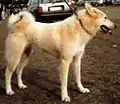
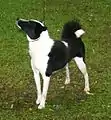
.JPG.webp)
